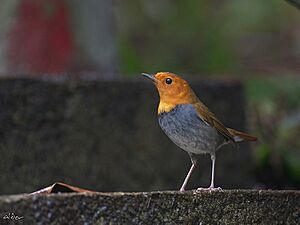Japanese robin facts for kids
Quick facts for kids Japanese robin |
|
|---|---|
 |
|
| Conservation status | |
| Scientific classification | |
| Genus: |
Larvivora
|
| Species: |
akahige
|
| Synonyms | |
|
Erithacus akahige |
|
The Japanese robin (Larvivora akahige) is a small songbird belonging to the Muscicapidae family. It was once known as Erithacus akahige or Komadori. You can find this bird from the southern Kuril Islands and Sakhalin Islands all the way across Japan.
Sometimes, the name "Japanese robin" is also used for another bird called the red-billed leiothrix. Interestingly, the scientific name akahige is actually the common Japanese name for its relative, the Larvivora komadori.
Scientists have studied the Japanese robin's family tree. It used to be grouped with the Ryukyu robin and the European robin. But later studies showed it was more closely related to the Siberian blue robin. Because of this, the Japanese robin and some other species were moved into a new group called Larvivora. This group includes the Japanese robin, the Ryukyu robin, and the Siberian blue robin.
Contents
What Does the Japanese Robin Look Like?
The Japanese robin is a small bird, about 14 to 15 centimeters long. It is mostly gray and bright orange.
Male Japanese robins have olive-brown feathers from their head to their back. Their face and neck are bright orange. Their chest and belly are gray. They have a reddish-brown tail, pinkish-brown legs, and a black bill.
Female Japanese robins look a lot like the males. However, their orange and brown colors are not as bright or widespread. Young Japanese robins also look similar to adults. They have dark spots on their chest and pale reddish-brown feathers on their head and back.
Where Do Japanese Robins Live?
Japanese robins live in places like islands, near lakes, in mountains, and in temperate forests. These areas have lots of small insects and plants for them to eat.
They especially like damp, thick, and shady spots. You can often find them in the undergrowth along valleys and streams. Many Japanese robins live in broadleaf and deciduous forests. These forests are found on the Japanese islands of Honshu, Shikoku, Hokkaido, the Sakhalin Islands, and Yakushima. In winter, some of them fly to Southeast Asia.
Special Robins on the Izu Islands
The Japanese robins living on the Izu Islands are quite far from the main groups. Because of this, they are often considered a special type, or subspecies, called L. akahige tanensis. The robins on the mainland are called L. akahige akahige.
These island robins look a bit different, especially in their feather colors. Also, mainland robins usually live in deciduous and mixed forests in summer. But the Izu Islands subspecies moves to warmer, lowland forests instead. Since these two groups are so far apart, they rarely mix. This means the Izu Islands robins often breed within their own small group.
What Do Japanese Robins Eat?
The scientific name for the Japanese robin, Larvivora, means "caterpillar eater." This gives you a big hint about what they like to eat!
They are known for eating beetles, other insects, small crickets, and even milled worms. They also enjoy fruits. Because they eat both insects and fruits, Japanese robins are considered omnivores.
Japanese Robin Reproduction
Japanese robins lay eggs and raise their young during May and June in central Japan. Their nests are usually made from moss, small twigs, dry leaves, ferns, and roots.
When a female is ready, she lays about 3 to 5 greenish eggs. She lays one egg each day. She then sits on the eggs, or incubates them, for about two weeks. Once the chicks hatch, their parents care for them for about a month (31 days). After this, the young birds leave the nest and become independent. Japanese robins do not stay with the same partner for their whole lives. They only find a mate during the spring breeding season.
Japanese Robin Song
The Japanese robin is considered a small songbird. Its song starts with a very loud single note, which then becomes softer as the song continues.
The robin's call sounds a bit like a telephone ringing. It has simple phrases that are well-spaced, along with short chattering sounds. Female robins tend to sing while they are building their nest and when they are sitting on their eggs. Male robins also sing, but they sing much less often once the eggs have been laid.


